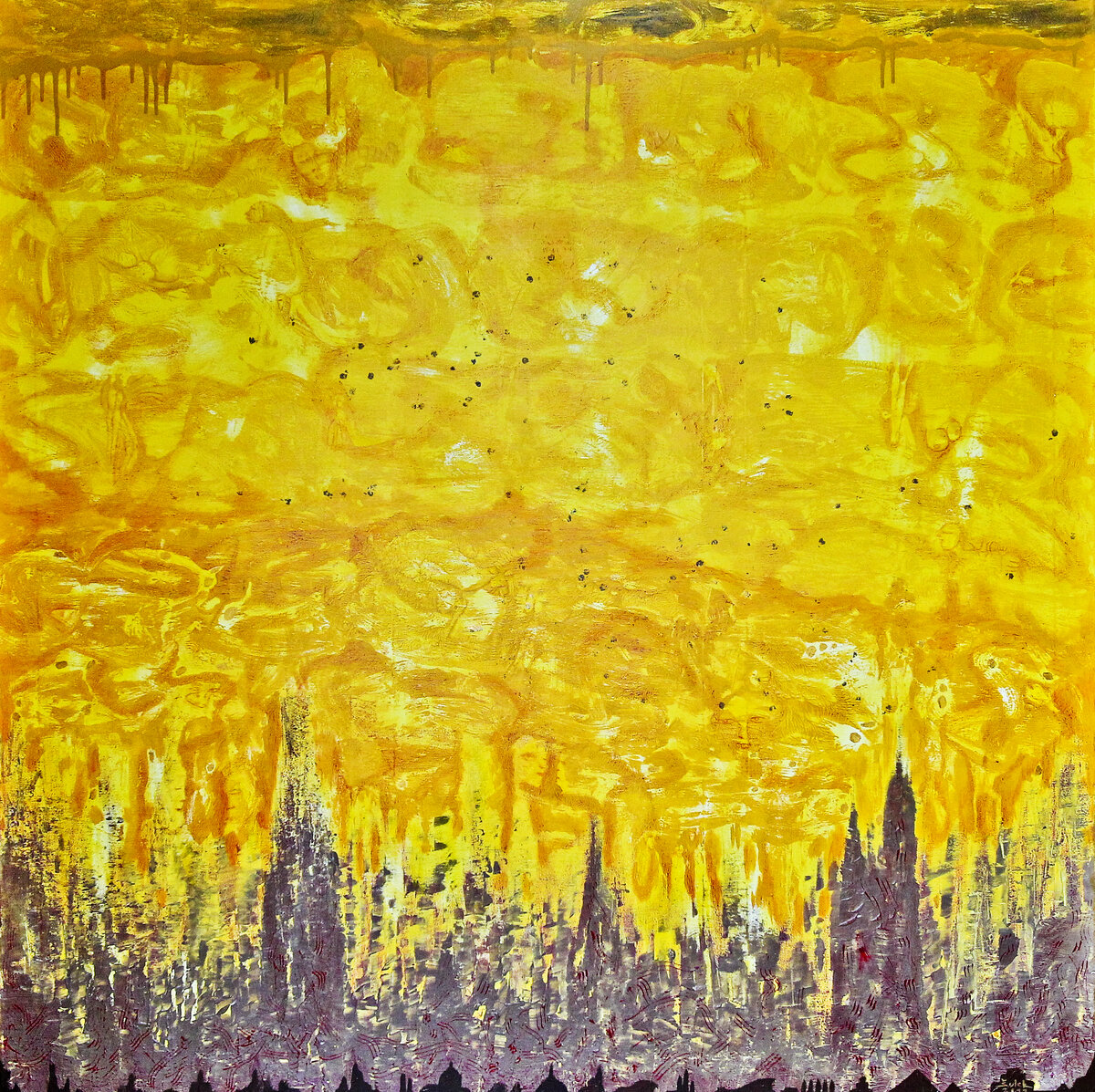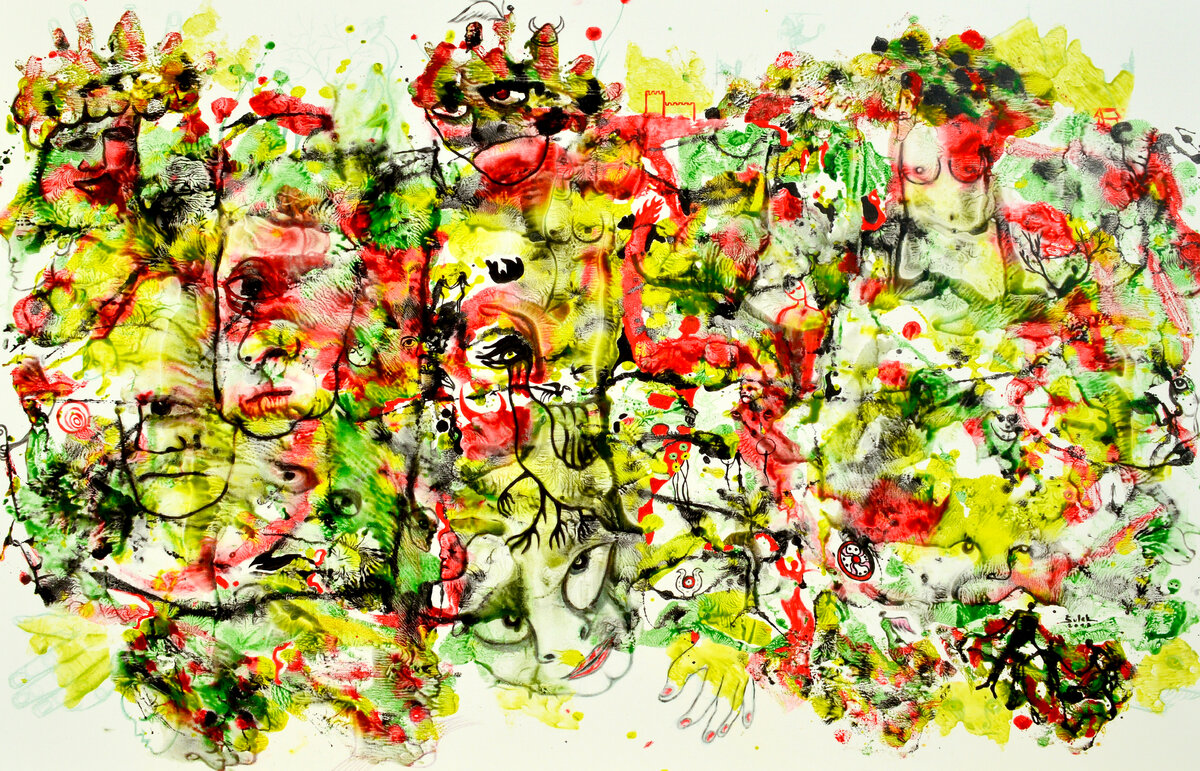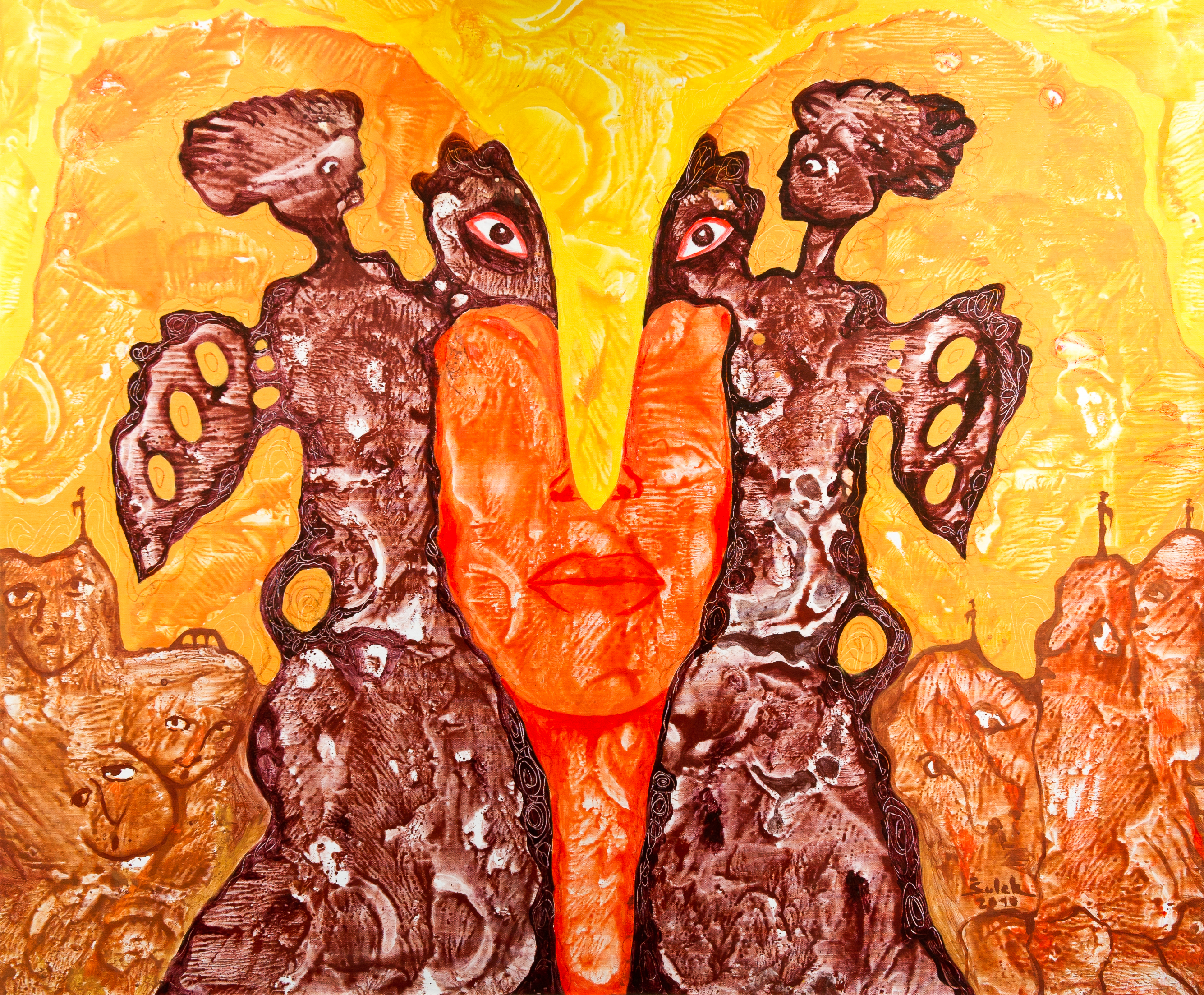Petránsky | Klebercz | Klivar REVIEW

“That art does not produce the visible but makes things visible – became the great definition of artistic representation…”
Painter Jaro Sulek
PhDr. Ľudo Petránsky (Slovakia)
A legendary claim by Paul Klee – that art does not produce the visible but makes things visible – became the great definition of artistic representation that even today feels like a powerful aura while opening the invisible gate into the world of art. Revealing seemingly invisible things is among the greatest skills of an artist – for whom to slide on a flashy surface of a momentary fame means a loss of energy. I’m convinced that the gate was precisely opened by a Slovak graphic artist Jaro Šulek, too. He and the great Swiss visionary have the spiritual substance of good art in common: delving in on the way to silence, and finding personal stories with original artistic chapters in the depth of hermits with secrets of the woods.
In the case of Jaro Šulek these chapters have been remolded into many touches with people’s energy. Man’s traces and traits of his desires often paint almost bizarre compositions in abstract spaces, and at the same time having a solid and clear expression. Everything concentrates in people’s faces. That’s where pain, anxiety, anger, hope and love are all mirrored. Contrasts of human feelings are different and as contrasting as are his characteristic surfaces on paintings. Autor himself admits a surrealistic drifting on psychic automatism and the flows of subconsciousness; however, his artistic impulses do not lie in dreams and eroticism only (as was the case with surrealists). His fundamental inspiration is the everyday reality surrounding us. Its invisible semantic colourfulness is being coded into readable signs of his artistic typicality. This typicality is created by the technique of dekalk, which happens to become an assistant of the artist’s intentions. Dapples shatter the painting into a mozaic of autonomous fields, but these fragments speedily gather into wholes to create a new reality – or, also, make things that come on surface more apparent.
Jaro Šulek belongs to the young generation of Slovak painters who continue in the further development of principles of the traditional hanging painting. They honour their craft, but this does not keep them from experimenting. The extent of artistic risks is levelled by their sovereign command of artistic compositions and application of painting pigments. In the case of Jaro Šulek, one can feel an artful play on colour, which creates figurative shapes, amorphous spots, and human emotions in many shapes. Painters know that the amount of energy they put into their paintings will in turn illuminate the audience. There is no calculation with the audience’s taste. Instead, artist takes them as a partner in a joint conversation – on beauty and ugliness, goodness and evil, tenderness and aggression. This is how Jaro Šulek provokes the audience’s mentality, and at the same time he brings them something they like. It‘s a fragile equilibrium of artistic sensibility.
PhDr. Ľudo Petránsky, Bratislava (Slovakia)
Jaro Sulek‘s art
Dr. Miroslav Klebercz de Rethe (England)
Jaro Sulek’s art, though very much extracted from the semi-automative and quasi-surreal so exemplary of late 20th century Slovak production, covers new ground by embracing and reacting to an all-engulfing global hyper-capitalism, an arch-system that has taken centre stage in Slovakia and monopolised its political, economic and social arenas. The ultra-rich hues of Sulek’s paintings, bleeding inexorably one into the other in a boundary-less quagmire, is reminiscent of the relativist exchanges of global hyper-capitalism. The system’s mass-products, produced in gaudy colours to catch the eye with just as vehemence and attraction in Slovakia as in the old notion of ‘the West’, extend their hold throughout the fabric of Slovak traditionally conservative society.
Like Sulek’s miniscule humanoids to be spied in his work, the modern Slovak citizen, surrounded by the multi-coloured grease that oils the hyper-capitalist machine, is thus ever more isolated from the long-surviving institutions of the nuclear family and close community interaction: and new relationships develop, relationships not only between real people but also between viewer and celebrity, consumer and the consumed. Sulek illustrates the modern Slovak citizen’s strategic surrender of the familial toe-holds of traditional society, in a move to rapidly assimilate with the social transformations of the West and its endless expansion of the product.
The work of Glenn Brown immediately invites comparison with that of Sulek. Brown however is the ultimate post-modern commentary, a visual trick that nevertheless in its seeping brushstrokes point to the chameleon-like relativism of modern society. Working beyond post-modernism to direct social and political commentary, Sulek however likewise illustrates the rapid breakdown in traditionally absolute values (substantially eroded during the 20th century in the West, but incubated in states such as Slovakia) and the resulting individual and communal chaos that can only be appeased by a larger quantity and sophistication of mass product. In its organic physical qualities, Sulek’s work resembles the blood and guts of Jake and Dinos Chapman: clearly Sulek’s organistic formations never reach the extremes of the Chapman trans-realistic and cadaverous putrefactions, and instead relate to the mass product as it must appear inside an individual’s imagination: attractive, fresh, yet confusing, shapeless, and eternally blended with psychotic desires to possess.
Sulek, therefore, uniquely straddles two entirely adversarial ways of being, the creative genius of the artist as it has ossified in the Slovak art-world, and the anabolic drive towards the visual trappings of a service industry, in which the offspring of a predominantly agrarian society embrace the symbols, attire, and world-view of values essentially alien but naturally globalised. As such it illustrates the inevitable and irreconcilable tension between the profundities of Slavic mysticism in art with a voracious and pitiless materialism. Sulek’s own working methods illustrate the ways in which these two seemingly irreconcilable arenas overlap, and perhaps even affirm each other. Sulek’s self-professed methods of interpreting an external spiritual world and existence, as opposed to internal and internalised dialogues that invite Freudian analyses, bring to the fore shamanistic connotations that in paradox appear to gain much credibility in contemporary art. The mock-fetishes produced by the Chapman brothers (seemingly ancient works of tribal art that reveal unmistakable McDonald’s symbolism, or similarly archaeological finds that are composed of plastic childrens’ masks of Pascale Tayou), as well as Sulek’s paintings, all attempt to clarify contemporary perceptions of the world and society through means that the Enlightenment perceived as barbaric or illogical. This form of contemporary mysticism, whose ultimate ancestors were the Surrealists and Dadaists, has matured into a form that can seriously challenge and create polemics around the most diverse political, economic as well as cultural issues.
Dr.Miroslav Kleberz de Rethe, London (England)
Critic of contemporary art in London,
Coutauld Institute of Art, London (History of Art)
The member of Contemporary Art Network Group C&A, London

Sulek, therefore, uniquely straddles two entirely adversarial ways of being, the creative genius of the artist as it has ossified in the Slovak art-world, and the anabolic drive towards the visual trappings of a service industry,..

“It is about aesthetically expressive dream modulated in condensed associations…”
Jaro Sulek – The painter of the invisible world
Prof. Dr. Miroslav Klivar (Czech Republic)
When I was reading a remarkable essay of the American aesthete Mark Rollins from the Washington University – St. Louis that was published in 2001 about,,The invisible Content in the visual arts” I realized that this notion and conception express the most truthfully the aesthetic substance of Jaro Šulek´s painting. From the point of view of the history of art Sulek creation undoubtably belongs to the avantgard movement of neosurrealism first of all by asserting of psychic automation when we speak “the dictate of thought without any rational control, not influenced by any aesthetic or moral consideration…” as it is said in Breton’s Manifests of surrealism. Let´s remember that Breton said that vigilance is some,, interference phenomenon”, in which the spirit is substance controlled by suggestions of the other subconsciousness that is revealed in a dream. The classic psychoanalysis has already claimed in mutual processes of consciousness and subconsciousness specification, imaginativeness, animism,etc. prevail in subconsciousness. However we needn´t take into consideration strictly Freud’s conception of the subconsciousness that should protect the individual against the possibilities of failed instinctive direction. It is the question of that according to psychoanalysis subconscioucness by means of dream manifests its contents. And now we are coming to the substance of the matter when specifying the dream in Jaro Sulek´s art., it is about aesthetically expressive dream modulated in condensed associations. It seems that first of all the night dream dominates because Sulek´s pictures remind night hallucination that appear and disappear again.
When we take into consideration this characteristics, we will understand why we speak about ,,invisibility in Sulek´s art : in the condensed dream the condensation is realized in the way that certain latent elements are not admitted at all later that from many elements of latent dream only fragments will penetrate into the manifestet dream.In automation of images this process is being dynamited even more and this enables to create “hidden“ images, the impression of invisible.
The modern (present) psychoanalytical aesthete Richard Wollheim speaks about,, going astray associations” for example in Sulek´s picture “The Pilgrims” (2000), we can see only fragments of human and animal figures, the aesthetic value is postponed into symbols. In the picture with the title ,, The Lake” (2001),symbolic totems directly appear.The autor himself joins the notion,,totem“at last in the Picture called,,At the Victorous Totem“(2002). To the aesthetic impression of ,,the invisibility“ the structural conception of the painting (decalks) belong as well.Colourful structures are so expressive, freely composed that they express excellently the next aesthetic value the magic image in Jaro Sulek´s thinking.The magic art sees a man as a collection of energies.And really,energy,living powers come out in every form, figurative and natural as well. For example in the artistic work called ,, A Dialogue of Three Beings”or ,,The Evening Act (2000) we feel directly the flow of energy.
In the case where the country is suppressed by the author (in the classic conception with the horizont), when everything is realized in the free space , the artistic expression is the most suggestive one.So we can say about the magic expression of the condesed dream. Sometimes the mentioned energies in Sulek´s pictures are manifested as aggression,fear.Already Freud spoke about the censorship of dreams that causes deformation of dream wishes.And that is the moment which way to free imagination, to ambiguity of marks in the Picture, especially symbols.Ritual belongs inseparably to the magic art. Sulek arrived at this cultural value especially in actions,performances where action prevails.His creation became a part of the avantgard stream of the action art reacts sensitively at the present civilization first of all by means of body actions.All features that we have mentioned at determination of autor´s aesthetics- expressive condensed dream is manifested here as well.To say more expressiveness makes actions and gestures of the body more effective.Of course,Jaro Sulek had to face the backwardness of the small town, provincial backwardness and misunderstanding.Maybe just for that reason he became the master of picturing the invisibility and the prophet of purification of human naturalness from sediments of wrath in the international merit.
Prof.Dr.Miroslav Klivar, Prague (Czech Republic)
President of the European Union of Art,
The member of Art Critics Association AICA Paris,
The member of the American society for aesthetic,
Professor of the World Distributed University Brusel.